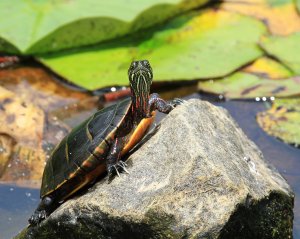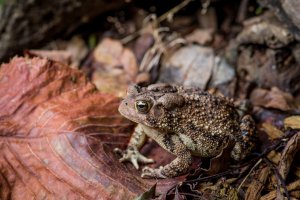How Do Michigan’s Animals Beat the Heat?
July 24, 2024
By: Maddie Lukens, Park Interpreter
We have all experienced a heat wave at some point in time, especially here in recent weeks in Southeast Michigan. Luckily, most of us are able to seek shelter in an air-

conditioned building, go for a cool swim, or simply find a large tree to relax under. But have you ever wondered what animals do to beat the heat? Just like people, Michigan animals seek to stay cool… by burrowing, seeking shade, taking a dip, and some even stranger strategies.
Pond plungers
Take for instance, Michigan’s state reptile, the painted turtle. This turtle is commonly seen basking in the warm spring sun, but come summer’s heat wave, how does it cope? Painted turtles, and many other Michigan turtles, will take a dip into cooler and deeper waters. Because reptiles are cold-blooded, or ectothermic, they rely on their environment to regulate their body temperature. You might even see a painted turtle basking in the sun on a log in the morning, and then in the afternoon heat, retreat to the cooler waters underneath.
Shade seekers

Another symbol of Michigan, the white-tailed deer, uses different strategies to stay cool. Unlike us humans who can excessively sweat to release body heat, the white-tailed deer is only able to sweat a little, if not at all. Its summer coat is much thinner than in the winter, allowing what little sweat they can produce to evaporate and cool down the animal more efficiently. Like other furry mammals, white-tailed deer pant if they require an even faster way of cooling down. Panting allows the animal to quickly expel hot air and take in cool air. This cool air then reaches the animal’s lungs, helping to cool down its body temperature.
Although white-tailed deer cannot sweat like we can, they can find a shady spot to cool down. It is not often that we see deer grazing in fields or out in the open in the afternoon in the summer, but more so at dawn and dusk. This is because they will limit their movement and stay in the shaded forest for our hot summer days. Forests, especially those which are conifer dominated, create their own micro-climate, that can be cooler in the summer and warmer in the winter than their surrounding habitats. Many animals will take advantage of this micro-climate as their midday retreat.
Tunnels, burrows, and hideouts

Now, moving onto a much smaller animal in Michigan, the American toad. This toad is mainly terrestrial, meaning it spends most of its time on land, unlike some species of frogs that take refuge in ponds to cool off. So, if it doesn’t hop into cool water, how does it stay cool in the summer heat? Because toads are amphibians, they breathe through both their lungs and skin. This means that they must stay somewhat moist to breathe properly. So, the American toad will burrow into the damp soil or leaf litter to both stay moist and cool in the summer heat. If you’ve ever had a toad in your flower bed or garden, they were probably trying to find a nice place to burrow!
Do not try this at home
These cooling strategies aren’t too far off from what humans have been doing for millennia, however, there is one Michigan animal who uses an especially unique strategy. This Michigan animal is the turkey vulture. You’ve probably seen these birds circling high in the sky, perched in trees, or near roadways on the search for their main diet of roadkill and carrion. You’ve probably also seen the white and brown liquid that falls from the sky, sometimes ending up on you or your property… you might see where I’m going with this. Yes, turkey vultures defecate on their own legs to cool down. While many of the strategies we’ve already discussed are common, this one is unusual even among wildlife! Bird poop is liquid at first and then slowly dries, essentially creating a similar effect that sweating does. The dried poop will aid in evaporative cooling and decrease the body temperature of the turkey vulture.

Cool creatures
All in all, Michigan animals have adapted to the heat that comes and goes in our Great Lakes region, however, these temperatures have become more extreme and variable in recent years due to climate change. Some animals struggle to adapt to the severity of our changing climate, coupled with habitat loss.
But don’t worry, you can help! Animals are the most susceptible to heat stress and heat related issues in urban areas due to their decrease in green space. So, if you have an urban backyard, offering shade and water are simple things you can do to help animals beat the heat!
Interested in learning more about how to help animals beat the heat in your backyard? Check out these other Metroparks’ resources:
- What is Garden Ecology?
- Harnessing the potential of Lawns
- Rain Gardens- Putting your yard to work for you (and your community)!
Sources:
https://www.nwf.org/Magazines/National-Wildlife/2010/animals_beat_the_heat
https://www.audubon.org/news/how-help-birds-beat-heat
